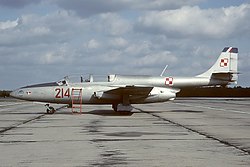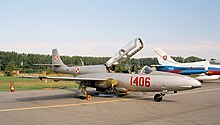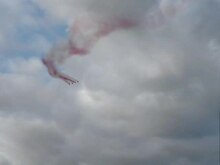PZL TS-11 Iskra
| PZL TS-11 Iskra | |
|---|---|

|
|
| Type: | Jet trainer |
| Design country: | |
| Manufacturer: | |
| First flight: |
5th February 1960 |
| Commissioning: |
1964 |
| Production time: |
1963-1979 |
| Number of pieces: |
424 |
The PZL TS-11 Iskra ( Polish spark ) is a Polish jet trainer (training aircraft), which was developed and built by the Polish aircraft manufacturer PZL Mielec in the 1950s . It was built until 1987, some copies were sold to India. They worked there until 2004. Poland still uses around 100 of its machines today.
history
prehistory
At the end of the 1950s, the Warsaw Pact countries were looking for a jet trainer for basic pilot training to replace the MiG-15UTI . This is why a corresponding model was built in Poland from 1958 under the direction of Tadeusz Soltyk (hence the name TS); however, there were corresponding studies as early as 1955. After wind tunnel tests with a wooden model , a first prototype was created that was used for static tests on the ground. The second of a total of four Iskra prototypes was launched on February 5, 1960 by test pilot Andrzej Ablamowicz for its maiden flight . He was still a Viper 8 -Triebwerk of Armstrong Siddeley equipped with 7.8 kN thrust. This was later replaced by the more modern and more powerful SO-1 from Polish production. With the exception of a few flutter phenomena, there were few problems on the first flight . With the third prototype, which had an enlarged elevator and a steering force booster, this problem could be eliminated. On September 11, 1960, the TS-11 was presented to the public as part of an air show taking place in Łódź . After a satisfactory state test, a fourth prototype was commissioned and the model was sent to the USSR in the autumn of 1961 for comparison flying against the competing designs Jak-30 and Aero L-29 . However, this comparison was in favor of the Aero L-29. The Iskra was then developed and built by Poland alone. The first series copies were delivered to the air force in spring 1964 , where they replaced the TS-8 Bies in 1965/66 . In 1963 an own simulator was developed, which also went into production.
Continuation of the program
In spring 1963 production was started as Iskra to A with initially low production rates and the HO-10 engine based on the Viper 8 with 7.8 kN thrust. When the SO-1 engine with 9.8 kN thrust was available from 1966, production of the machine now known as Iskra to B (or Iskra 100) was ramped up. This version also had four instead of two under wing stations for external loads. From 1969 onwards, weapons containers could also be installed on it. In the same year, the SO-3 engine with a longer service life was also used. In the following years the Iskra was only slightly developed. In 1972 five single-seat reconnaissance aircraft with camera equipment were built as Iskra to C (also Iskra 200), but were dismantled to trainers in 1983. In 1979 production was stopped. India was the only export customer and bought 50 copies of version D of the jet trainer in the 1970s, which were delivered between October 1975 and May 1976. From 1982 to 1987 another series of 45 aircraft was built, these carried the version designation DF. Today around 100 planes are still flying in Poland and are expected to remain in service until 2012. India put its 34 still existing and one third still airworthy machines out of service at the end of 2004.
In addition to the Polish Air Force and the Polish Navy (as a reconnaissance aircraft until February 2003), the Polish Biało-Czerwone Iskry aerobatic team has also been using machines of the type since 1969 .
Technical details
The Iskra is an all-metal aircraft with a middle - wing, half-shell construction . It has trapezoidal wings with integral fuel tanks, air brakes and integrated air inlets with protective grilles under the wing roots. The engine nozzle is located under the tail unit, which gives the aircraft a rather unusual silhouette. The engine itself is installed directly behind the cockpit. Both crew members sit in a pressurized cabin on ejector seats that can be operated from an altitude of 250 m. The aircraft has no radar (except for the T-11R version). In the bow there are the avionics, a photo machine gun or a 23 mm cannon for weapons training. The three-point retractable landing gear in a nose wheel arrangement has low-pressure tires that do not allow operation from unpaved areas.
Versions
- TS-11 Iskra : First series machine, this was still equipped with the HO-10 engine.
- TS-11 Iskra bis : First production version with a more powerful SO-1 engine
- TS-11 Iskra up to A : Improved version, could carry up to 200 kg of external loads
- TS-11 Iskra to B or TS-11 Iskra 100 (designation of the prototype): This version, produced from 1969, had a larger load capacity than the previous version with four suspension points under the wings.
- TS-11 Iskra to C or TS-11 Iskra 200 Type : Single-seat reconnaissance version. This could be equipped with cameras. A total of only five machines were manufactured, these were upgraded to normal trainers in 1983.
- TS-11 Iskra to D or TS-11 Iskra 200 SB : Jet trainer, was produced from 1973. This version had an extended weapon load of 400 kg and a new engine. In the mid-1970s, 50 machines of this version were delivered to India. From 1972 also tested as a single-seat fighter-bomber TS-11 Iskra 200 BR but not mass-produced.
- TS-11 Iskra to DF : This version could be used both as a trainer and as a reconnaissance aircraft, it completed its maiden flight with the new SO-3W engine with 10.78 kN thrust in 1975. The three cameras were housed in the air intakes.
- TS-11 Iskra (DF) R : This version is the only one equipped with a weather radar and a corresponding display in the rear cockpit. In 1991 a total of six machines from the version up to DF were converted, five of which are still in use today. They have AFA-39 cameras, a Bendix RDS-81 weather radar and a GPS.
- TS-11 Iskra MR : Version with modern avionics adapted to ICAO standards . This version has been flown by the Iskry team since 1998 and is still used today by Siły Powietrzne Rzeczypospolitej Polskiej .
- TS-11F : planned modernized version with glass cockpit. Unrealized.
user
-
 India
India
- Indian Air Force (76 pieces)
-
 Poland
Poland
- Polish Air Force
Technical specifications
| PZL TS-11 Iskra to DF | |
|---|---|
| Parameter | Data |
| length | 11.15 m |
| Wingspan | 10.06 m |
| height | 3.50 m |
| Wing area | 17.50 m² |
| Wing extension | 5.77 |
| drive | a WSK SO-3W |
| power | 10.8 kN |
| Top speed | 720 km / h |
| Rate of climb | 14.8 m / s |
| Service ceiling | 11,140 m |
| Range | 435 km without additional tanks 1,260 km with additional tanks |
| Start and landing distance |
725 m / 660 m |
| Empty weight | 2,560 kg |
| Takeoff weight | 3,840 kg |
| crew | 2 |
Armament
Barrel armament
- 1 × 23 mm Nudelman-Richter NR-23 automatic cannon with 150 rounds of ammunition in the bow
Drop weapons
The Iskra can carry up to 400 kg external loads on four suspensions under the two wings.
- Unguided air-to-surface missiles
- 4 × Mars-4 rocket tube launch containers for 4 × unguided S-5 air-to-surface missiles each ; Caliber 57 mm
- Additional container
- 4 × ZEUS-1- automatic cannons vessels for
See also
literature
- Karl-Heinz Eyermann : beam trainer . German Military Publishing House , Berlin 1971, p. 60/61 .
- Wilfried Copenhagen : TS-11 "Iskra" . In: Illustrated series for type collectors . No. 32 . German military publisher, Berlin 1967.
Web links
Individual evidence
- ↑ FliegerRevue February 2010; Pp. 28-31; The "spark" is still on - the jet trainer TS-11 Iskra turns 50.






